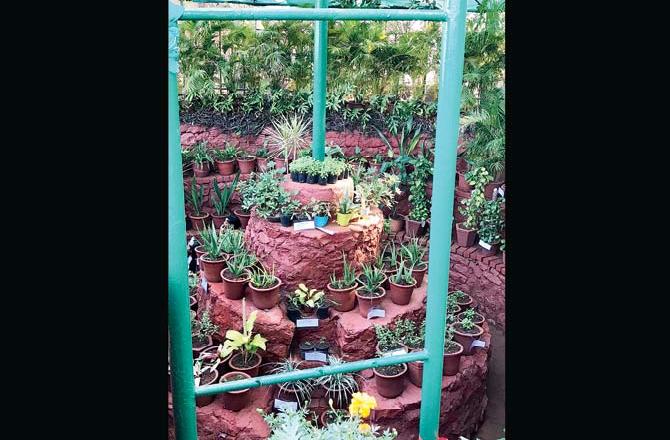An old, dilapidated bawdi (well), tucked away in a corner of the Hanging Gardens at Malabar Hill, has undergone a facelift to give Mumbaikars an oxygen hub. The green zone, with free entry, houses a number of plants, including aloe vera, peace lily and pothos, which give off oxygen even at night.
So, how does that happen? Plants need sunlight for photosynthesis that in turn helps them produce oxygen, but at night, certain plants undergo Crassulacean Acid Metabolism or CAM photosynthesis to produce oxygen.
Article source: Mid-day.com
“At night, only respiration occurs in plants, i.e. inhaling oxygen and releasing carbon dioxide. However, some studies have shown that photosynthesis in some plants occurs at night as well. This process is called Crassulacean Acid Metabolism (CAM), which primarily occurs in desert plants that live off other plants. The plants that undergo CAM have been used in the oxygen hub at the Hanging Gardens [also known as Pherozeshah Mehta Gardens],” said Sagar Doiphode, horticulture assistant, Malabar Hill Reservoir Garden, Hydraulic Engineering Department.
Doiphode said the green park “started as an idea about two months ago. I did plenty of research and said to myself, let us, my team of BMC workers and I, give the public something that they can enjoy free of cost, and ensure that we are very cost effective while making it. We zeroed in on the area and we have used plants that are grown in our nursery. There are approximately 100 plants of which only two are from outside. The neem plant is from Solpaur and the Christmas cactus is from the Rani Bagh. The sand we use is the powder from stone grouting. I have seen fancy oxygen parks, but I did not want this hub to intimidate those who may feel that they do not have access to fancy parks.”
Learning Point
Sanjay Shirke, an activist, said, “Can one have too much green in a city that is consumed by concrete? This is an area where residents may have four and five cars; one for each family member. Therefore, pollution level is too high. An oxygen hub is a useful facet in this garden.” When this reporter visited the hub, there was a green signboard at the entrance with the names of all the kinds of trees and plants inside. A few steps lead you to the oxygen park that is below ground level. There is a cool, earthy feel about it.
Prakash Munshi, a local who visited the hub, was awestruck by the information provided about the plants, which makes one’s visit a truly educative experience. Munshi, however, had a suggestion for the civic body. “I think a railing along the stairs would be useful for the senior citizens. Maybe, it would be good to number the plants too,” he said.

The signboard at the entrance explains about the hub
Doiphode agreed with Munshi and said he has received the same suggestion from other senior citizens as well. “We will act on those suggestions. We will also see if schools can bring children over here, as this is also a learning experience,” he said, adding that they are yet to finalise the timings for the hub, which was opened two days back.
The BMC workers wish that this hub becomes an inspiration a model that can be replicated in other places, like civic hospitals, malls and parking lots. “We are going to try and make a second, bigger hub within the park. We have already earmarked a spot,” said Doiphode. “The accent should be in a place where there’s peace and that invigorates people,” said the horticulturist about the project that gives meaning to the adage: the best things in life are free.
What Is CAM?
There are plants that do not open their stomata (pores) on leaves in daylight to store water. When dark, they open their stomata, use the carbon dioxide and store them in the form of malate. Later, they break down this malate to produce glucose and oxygen like in photosynthesis. Although the amount of oxygen they produce at night is less than what they make in the day. A plant’s capability to store water is one of the major factors for CAM. Plants like aloe vera, snake plant, areca palm, orchids, gerbera (orange), Christmas cactus, tulsi and money plant (pothos) and peepal and neem trees produce oxygen at night.
100 Approx no. of plants inside oxygen hub
Article source: Mid-day.com








